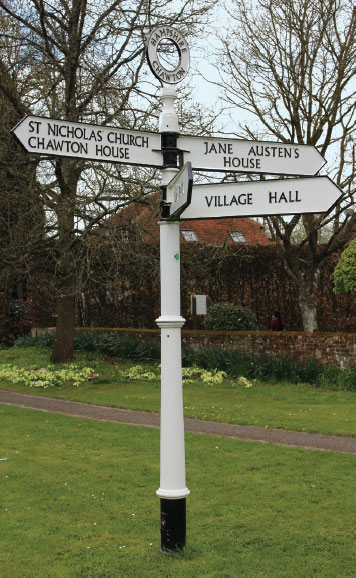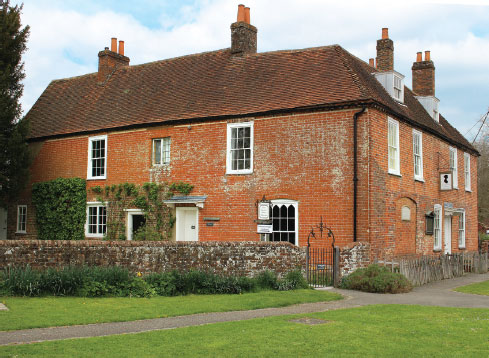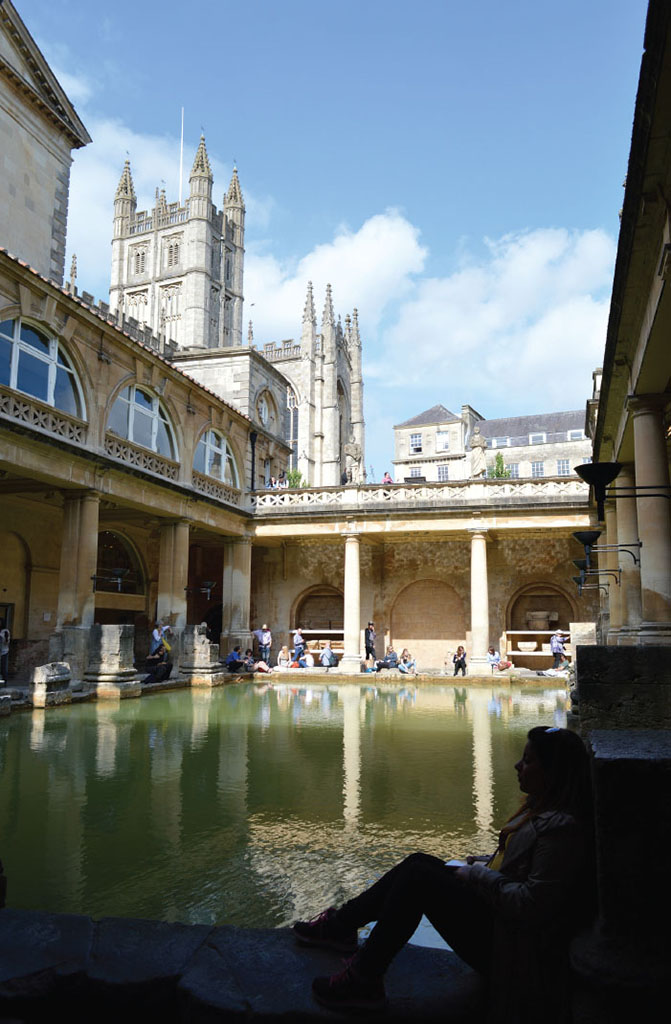
Here, Sandra gazes out over the lake at Blenheim Palace in the best Regency style!
Sandra Lawrence blazes the trail in Jane Austen's the West Country and shares her experience.
“My idea of good company, Mr. Eliot, is the company of clever, well-informed people who have a great deal of conversation,” writes Jane Austen in Persuasion. Surely there can be no more important ingredient for any holiday than the people you are with.
Not everyone on the Jane Austen’s West Country Charms tour was an Austen fanatic; after all, the region does have charms nothing to do with the divine Jane. One or two fellow travelers had (shock! horror!) not actually read her work, though everyone had seen screen adaptations.
What bound us, then, was conversation. On the coach, as we walked, over supper, in twos and threes, as a whole group. Increasingly, subtly, Jane infiltrated. As we got to know our heroine through the places she knew, loved, and, occasionally, hated, we found ourselves drawn into her world.
“What would Jane do?” we’d ask in moments of indecision. Tongue in cheek, perhaps, but also with a sneaking desire to experience the beauty of England’s West Country through her eyes. Much of her countryside is unaltered; cities, such as Bath and Winchester, retain enough of Jane’s spirit to be able to sometimes almost literally follow in her footsteps.
We were a small group for such a large coach. A full-size, 32-seater luxury job with just 11 guests meant plenty of room to spread out, and even visit the “library”: a large cardboard box provided by Elle, our tireless tour guide, containing maps, leaflets about the places we’d be visiting, books about Austen and the West Country and DVDs of classic Austen movies to watch in our rooms after dinner.

DANA HUNTLEY
Of course on a trip like this, it does help to know Jane Austen’s work and, to some extent, her biography, but frankly, by the time we’d listened to expert guides on the first couple of days, we knew the basics back to front: born 1775, unmarried, often financially squeezed, died at 41, sister burned the letters. Oh, and she wrote some of the best-loved novels of all time. The rest we filled in as we went along.
The charming village of Steventon, where Jane was born, remains as sleepy, green and lush as it was 200 years ago. Her father was rector of the delightful 12th-century church of St. Nicholas, nestled peacefully outside the village center. Jane would have been very familiar with its simple lines and a squat, square tower, though not the spire, which was added after her death.
In the still June morning, misty and moist, the little church’s severe lines were softened by a mass of flowers around the doorways, at the end of each pew and adorning every niche. St. Nicholas’s was festooned like the last scene in every Austen movie—the one where the heroine finally marries the man she loves and the whole village turns out to celebrate.
As we walked around the stark interior, admiring memorials to Jane’s brother and sister-in-law, a soppy old dog snuffled inside, closely followed by a local couple. Parents of the previous weekend’s bride, they’d tramped across the fields, much as Jane might have done, to say hello. Sadly we were unable to say hello to the house where Jane spent the first 25 years of her life, as her brother Edward demolished it in 1823. What would Jane do? Get over it and move on, as did we.

Jane, her mother, and her sister, Cassandra, lived together in Chawton in a Georgian brick house with lovely gardens in the center of the village. Sandra Lawrence
Jane’s life story influenced her novels more than casual reading might suggest. She genuinely believed she should marry only for love. It was clear she’d be unable to marry dashing Thomas Lefroy (neither of them was rich enough to keep the other), but despite initially accepting the wealthy but dull alternative, one Harris Bigg-Wither, she ultimately chose spinsterhood—a cardinal sin in Georgian times. Jane would have seen it as freedom. Seeing how she later lived, it becomes clear why all of Austen’s heroines are so desperate to marry money, but love had to come into the equation. And, selfishly, could we possibly have loved a romantic novel written by Jane “Bigg-Wither”?

Jane’s mother and her sister Cassandra are buried in the churchyard of St. Nicholas in Chawton. DANA HUNTLEY
Austen made a little money from Sense and Sensibility, her first published novel, but nowhere near enough to keep her and her family. When her father suddenly announced he was retiring and moving everyone to Bath, it came as a shock. She should have been delighted; when she’d visited before it had been as a giddy, marriageable young thing, her head full of parties and dancing, the city bustling with the most stylish young blades in England. Now 25 and still unmarried, she saw a different side of the city. The trendy set had moved to Brighton to join the Prince of Wales; Bath’s mellow stone circuses and chattering assembly rooms had become the domain of retired admirals and aging clergymen. Austen hardly wrote anything in the eight years she lived there.

The shop fronts of Milsom Street would be recognizable today to Jane and her heroines.
Jane might not have liked it, but today Bath is a highlight of any Jane Austen–related trip. Our group determined to see the city through her younger, happier eyes, when she wrote breathlessly of balls and theater visits, describing the daily ups and downs in her satirical novel Northanger Abbey. Julianne, Mary-Louise, and I stood in the great ballroom at the Assembly Rooms where Jane danced, admired dainty clothes of her day in the Fashion Museum, visited the Abbey, and promenaded the Circus. We passed elegant Regency shopfronts in the main streets and marveled at Robert Adam’s Pulteney Bridge, one of just four in the world with shops on both sides.
Jane may well never have set foot inside Number One, the Crescent, but this beautiful house, home to one Henry Sandford between 1776 and 1796, has been stunningly returned to a neoclassical glory Austen would have been familiar with. We were treated, over coffee, to a talk by the housekeeper before exploring every chamber, from the grandest drawing-room, full of bone china, fine furniture, and elegant views to the humblest scullery with its polished copper, gleaming china and curious, dog-driven rotary spit.
Bath enjoys so many places to eat we were spoiled for choice. What would Jane do?

Sally Lunns remain a Bath specialty.
It’s said Solange Lyon arrived in Bath in 1680 as a French Huguenot refugee with a recipe for a brioche-style bun, suitable for sweet and savoury dishes. Soon “Sally Lunns” were all the rage. Jane Austen “disordered” her stomach eating so many of them, so Jocelyn, Susan, and I did much the same. Confusingly they are not the same as the sweet, sugar-crusted “Bath buns” on sale elsewhere, a Victorian invention created in London for the Great Exhibition.
The Roman baths were rediscovered when the glorious Pump Rooms were enlarged but had not yet become a tourist attraction. Northanger Abbey describes the hubbub around the health-giving but foul-tasting waters in the Pump Rooms; we preferred the afternoon tea.

While the famous Roman baths had been discovered in Jane Austen’s day, for the 18th-century social scene, the attraction was the warm, high mineral spring water—delivered in the elegant Pump Room to be ceremonially drunk for its health-giving properties. Sandra Lawrence
In 1805, Jane’s father died. The Austen ladies were left in impecunious circumstances, in a city they disliked. In a quirk of fate straight out of one of her own novels, however, Jane’s brother Edward had been adopted by wealthy distant relatives, the Knights, who had no children of their own. The Knights made Edward their heir, and he changed his surname to Austen-Knight in gratitude. Jane and her sister Cassandra were also grateful, accepting their brother’s offer of a cottage in Chawton, East Hampshire.

On many a wet afternoon, Jane might have stared out the mullioned window toward the laundry room and donkey stable behind the house. Sandra Lawrence
Edward lived in the “big house,” Chawton House, now home to the Centre for the Study of Early Women’s Writing. We were delighted to meet Jeremy Knight, great-great-grand-nephew of Jane Austen, who grew up there and knows the house, and Jane’s work, intimately. The geography described in Emma has convinced him the novel’s setting, Highbury, is based on Chawton. After touring this delightful, cozy manor house, we did what Jane would and did—explored the gardens, in whose creation she was much involved, then walked the lush, green path to her own home.
It was pouring with rain. Cottage garden flowers bowed underwater; the chap up a ladder mending a thatched roof must have regretted his choice of day. As we tramped past damp fields of damp horses munching damp buttercups, I felt like Elizabeth Bennet, refusing the coach and walking to Netherfield, muddying her gown. I’m not sure my eyes were “brightened by the exercise,” and my glasses steamed up when we finally stepped inside the Jane Austen House Museum.
Jane flourished at Chawton. Her famous writing desk sits by the window, slightly scruffier and much smaller than I expected, but positioned where she might watch the comings and goings of the inn opposite. Three pieces of her jewelry live upstairs: a turquoise bracelet, gold ring, and the famous amber cross, which put me in mind of the necklace in Mansfield Park.
It’s not a minute cottage, but for four lively women ( Jane, her mother, sister, and friend Martha Lloyd) it can’t have been socially stimulating. It was easy to imagine the Bennet girls, especially Kitty and Lydia, going stir-crazy. They must have craved someone to play the pianoforte. We were lucky enough to be there when a local music student arrived and did exactly that.
Kitty and Lydia would have loved our next visit: Meryton, village of bonnets, lace, and officers, or its nearest real-life equivalent, Lacock in Wiltshire, used in the 1990 BBC TV adaptation of Pride and Prejudice. Badly marred by parked vehicles these days, the village still has charms: beautiful, mellow stone, quaint cottages and surprising shopping opportunities—homemade cakes, eggs, preserves, and plants, left on steps, walls, and porches, with little notes to put the money through sundry letterboxes. If the unofficial outlets were adorable, I caught Gert and Susan stocking up on British sundries in the exquisite village stores. The abbey, dissolved by Henry VIII and more recently home to photographic pioneer William Fox-Talbot, retains its sleepy romance and sacred atmosphere.
Mompesson House in Salisbury and Montacute House in Somerset are both famous for their appearances in Ang Lee’s exceptional 1995 film of Sense and Sensibility. The rain was torrential again as a few of us braved Salisbury’s cathedral close, but it was easy enough to see how beautifully it had stood in for early 19th-century London.
The world-famous gardens at Stourhead, setting for the final scene in the 2005 movie of Pride and Prejudice, are stunning in their own right. Judith and I climbed through a rainbow of rhododendron blossom to the Temple of Apollo to gaze down on that Palladian bridge and wave at Madge, Lyn, and Cynthia, who had sensibly taken a buggy ride.
Winchester is a sad episode in Austen country. Jane died there, and although it’s a beautiful city with an even more beautiful cathedral, her grave, permanently marked with flowers, is a poignant sight. Chawton, however, was not far from the city. There are shops to visit, inns to enjoy and the great round table of King Arthur to be marvelled at. In happier times, I like to think that’s exactly what Jane herself would have done.
Read more
* Originally published in May 2017.





Comments